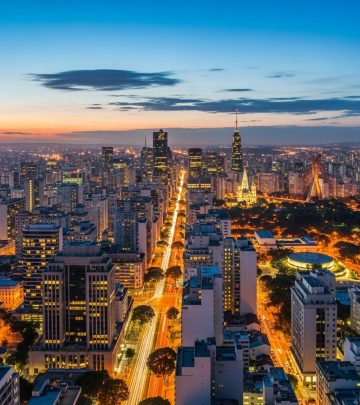Krampus Run Munich: Celebrating Alpine Tradition with a Festive Twist
Experience Munich’s legendary Krampus Run, where Alpine folklore meets festive celebration in one of Europe’s most lively winter parades.

Krampus Run Munich: A Celebration of Alpine Folklore
Every December, Munich erupts with energy and folklore as the Krampus Run takes over the city center. With origins reaching back centuries into the Alpine regions of Europe, Krampusnacht and its Krampuslauf (the traditional Krampus Parade) blend ancient myth with contemporary festivity, thrilling thousands of locals and visitors alike. This guide captures the spectacle, stories, and customs that make Munich’s Krampus Run a can’t-miss winter event for culture seekers and holiday enthusiasts.
What is the Krampus Run?
The Krampus Run (Krampuslauf) is a striking holiday parade in which hundreds of participants don elaborate, beastly costumes and roam Munich’s pedestrian zones, celebrating an ancient custom designed to banish evil spirits and discipline mischievous children. Far from a simple spectacle, the run weaves together history, folklore, and community, evoking both awe and laughter in onlookers of all ages.
The parade’s roots are deep, echoing through the traditions of southern Germany, Austria, northern Italy, and beyond. Krampus, often depicted with horns, fangs, and shaggy fur, is the gloomy counterpart to Saint Nicholas, embodying the fears and mythos of winter’s darkest months.
When and Where Does the Krampus Run Happen?
- Date: The main Munich run typically takes place the Sunday after December 6 (Saint Nicholas Day). In 2025, it’s scheduled for Sunday, December 14, from 3 to 5 p.m.
- Location: The parade winds through the city center, starting on Augustiner Straße and traversing the pedestrian zone past Färbergraben, Rosental, Viktualienmarkt, and concludes by the Old Town Hall and Marienplatz.
- Participants: Over 300 costumed figures are part of the run, representing more than 25 groups from across Bavaria and the Alpine region.
- Audience: Up to 50,000 spectators line the streets to witness the spectacle, making it one of Germany’s largest Krampus celebrations.
Origins and Legends of Krampus
The figure of Krampus emerges from Old High German roots: ‘Krampen’ means claw, befitting the beastly appearance of these parade monsters. Legend states that Krampus punishes naughty children while Saint Nicholas rewards the well-behaved with gifts, echoing themes of discipline and reward common to winter tales across Europe. First references date as far back as the 16th century, with grisly woodcuts and tales of horned, fur-clad monsters instilling both fear and excitement in the hearts of children. Greeting cards called Krampuskarten, featuring these frightening figures, were exchanged in the 1800s with ‘Gruß vom Krampus’ (Greetings from Krampus).
Key Historical Milestones
| Period | Event |
|---|---|
| Pre-Roman / Celtic Era | Earliest forms of winter demon-banishing rituals |
| 16th Century | Klabaufs (wild, demonic processions) recorded in southern Germany |
| 17th Century | Krampus tradition revived as companion to St. Nicholas |
| 1800s | Krampus greeting cards become popular cultural exchange |
| Present Day | Parades, contests, and community celebrations across Alpine Europe |
The Parade Experience: Sights and Sounds
During the Munich Krampus Run, costumed figures storm the streets with bells, chains, birch bundles (known as Rute), and baskets. The air reverberates with the clang of bells and the laughter of both participants and onlookers. While in the past, children (and even adults) risked bruises from an errant Krampus whack, today’s Munich spectacle has softened: the creatures now playfully interact with crowds—giving high fives, posing for selfies, and engaging in good-natured pranks.
- Older children might receive a comedic fist bump from a Krampus.
- Parade monsters jest with spectators, occasionally swiping hats and returning them atop a horn.
- Krampuses comically slap each other with their birch switches.
- Groups include both men and women, with some figures (Bärbele) providing added folklore diversity.
The parade route embraces Munich’s festive market atmosphere—the Christkindlmarkt—where families cluster near hot mulled wine stands, sampling local holiday treats as the procession passes.
Costumes: Tradition and Craftsmanship
One of the most unique aspects of the Krampus Run is the elaborate costumes worn by participants. Each outfit consists of:
- Masks: Fiercely carved, often featuring fangs, horns, and ghoulish details.
- Animal Skins: Predominantly goat or sheep, sometimes up to 10–20 kg in weight.
- Large Bells: Secured to heavy belts, clanged vigorously throughout the parade.
- Chains: Rattled to enhance the atmosphere and frighten away evil spirits.
- Birch Bundles (Rute): A symbol of discipline, used today more playfully than threateningly.
Creating a Krampus costume is a serious commitment. A basic suit may cost 2,000 euros or more, reflecting the attention to authentic detail and material quality required for the distinctive Alpine look.
Event Schedule and Logistics
Munich’s Krampus Run is meticulously organized and financed by the Department of Labor and Economic Development, in collaboration with the city’s oldest Krampus group, Sparifankerl-Pass. Each year, the route and timing can slightly change, so official city websites and the Christkindlmarkt site provide updated details.
- Main event: Sunday, December 14, 2025 (3–5 p.m.)
- Line-up: Augustiner Straße, pedestrian zone
- Route: Färbergraben, Rosental, Viktualienmarkt, Old Town Hall, Marienplatz
- Accessibility: Barrier-free access, large print & Braille texts, sign language translation, induction loops for hearing-impaired spectators. Guide dogs allowed.
Regional and International Spread
The tradition of Krampuslauf is not limited to Munich:
- Sonthofen: Around December 6
- Oberstdorf: December 4 (Bärbele, Klausentreiben)
- Austria: Over a hundred Krampus runs from November through early January
- Salzburg: December 5 & 6
- Klagenfurt: Late November
- Carinthia: November to mid-December
- Bavarian Forest: End of December, including Eisenstein near Czech border
Across southern Bavaria, Tyrol, northern Italy, Czechia and neighboring regions, similar winter demon-banishing processions—such as Perchten runs—bring communities together with shared custom and friendly competition.
Krampusnacht and Holiday Customs
Krampusnacht takes place on December 5, the night before Saint Nicholas Day. It is marked by fearsome Krampus processions, gift giving, feasting, and contests. The raucous noise of bells and chains is believed to ward off evil spirits, while the playful scare tactics of Krampus remind children to be on their best behavior throughout the year.
- Krampus Parades: Main feature; elaborate costumes, bell-ringing.
- Frightening the Naughty: Krampus rattles chains, brandishes switches.
- Holiday Merriment: Communities balance the dark with feast and gift giving.
- Costume Contests: Modern element, rewarding creativity and craftsmanship.
Modern Krampus Run: From Terror to Fun
The contemporary Munich Krampus Run preserves a balance between tradition and safety. Once known for genuine bruises and rowdiness, today’s parade is much more family friendly, focused on smiles, photos, and embodying the spirit of joy and mischief. Local authorities, parade organizers, and tradition-bearers have adapted the custom, blending age-old spectacle with accessible entertainment.
Tips for Visitors
- Arrive early to secure a good spot along the parade route—by Marienplatz or Viktualienmarkt are popular.
- Dress warmly; December in Munich is cold and often snowy.
- Try the Christkindlmarkt’s mulled wine and regional pastries.
- If attending with children, explain the tradition and encourage playful interaction—Krampus is now much more approachable!
- Accessibility needs are well covered; look for provided services if required.
- For a central overnight stay, the Do & Co Hotel is recommended for its proximity to the parade route and main attractions.
Frequently Asked Questions (FAQs)
Q: What is the exact date and time of the Munich Krampus Run?
A: The 2025 Krampus Run in Munich takes place on Sunday, December 14, from 3 to 5 p.m; check city event calendars for updates.
Q: How many groups and participants take part in the parade?
A: Around 25 groups with more than 300 costumed participants join the Munich Krampus Run each year.
Q: Is the Krampus Run suitable for children?
A: Yes. While the costumes and noise can be intimidating, today’s parade encourages friendly interaction with kids, often giving high-fives and posing for photos.
Q: How heavy and expensive are Krampus costumes?
A: Costumes are crafted from natural skins and horns, often weighing 10–20 kg; a typical costume may start at 2,000 euros and go higher depending on craftsmanship.
Q: Can international visitors experience this tradition elsewhere?
A: Yes. Krampus runs occur throughout Alpine Europe, with similar events in Austria, northern Italy, Czechia, and Bavaria.
Krampus Run: A Living Tradition
Munich’s Krampus Run is more than a tourist event—it’s a vibrant celebration of Alpine folklore, interactive history, and festive spirit. For many, it marks the true start of the holiday season, blending local culture, ancient myth, and communal joy in an unforgettable experience. Whether drawn to lore, spectacle, or simply the thrill of the parade, attending the Krampus Run promises lasting memories—and perhaps a playful scare!












